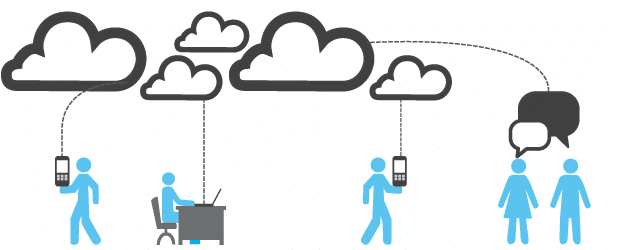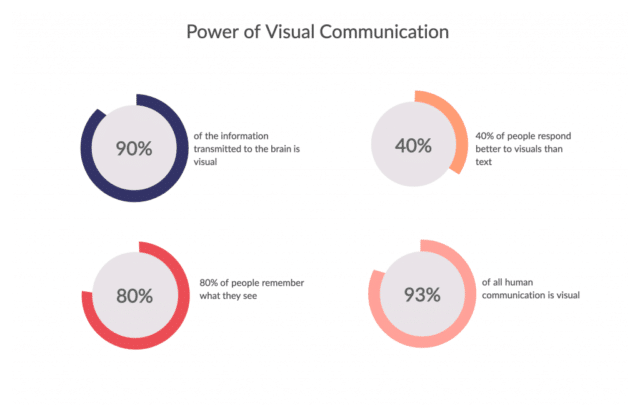In this article, we'll cover:
What is cloud collaboration?
Cloud collaboration is a team collaboration method where colleagues can work together on documents housed in the cloud, with everyone able to access the same files and edit them in real-time.
Team members can view and edit the documents at any time, from any location – including when they are working simultaneously. Edits are visible to all team members as they are made, and changes are saved and synced so that every user sees the same version of the project.
Cloud collaboration eliminates the confusion caused by having multiple versions of the same documents or the trials of attempting to merge resulting files.
The rapid growth of cloud computing services and collaboration technologies has obvious benefits for remote and hybrid workforces. It enables teams to work together and achieve their shared goals without being together physically in the workplace.

86 per cent of respondents in a recent survey believed that lack of collaboration had caused the failure of projects on which they had worked. That’s why more and more companies are turning to cloud collaboration services, with the global enterprise collaboration market expected to reach $48.1 billion by 2024.
Below, we’ll take a look at some more of the benefits of using cloud collaboration.
Benefits of cloud collaboration
Cloud collaboration helps to build a sense of community through teamwork, increases productivity and stimulates creativity.
Using this method makes it easier to make the transition to a remote workforce. That’s thanks to the associated benefits of reducing company overheads, minimising the environmental impact of commuting, and improving employees’ work-life balance.
Streamlines organisation workflow
Cloud collaboration improves productivity by helping teams work faster and more efficiently. It’s also perfect for flexible work scheduling since tasks can be shared between collaborators with varying working hours and colleagues in different time zones.
Using cloud storage means everyone has easy access to all the documents they need, and they can share files from wherever they are, at any time. This reduces the amount of time spent waiting for information and decisions. Plus, there’s no need to send updated versions to the relevant co-workers.

Improved communication and participation
Communication is vital to successful projects, especially in a distributed workforce. Cloud collaboration allows for a higher degree of employee participation, as the 24/7 accessibility of files gives all team members an equal opportunity to provide input.
Cloud-based collaboration tools also enable colleagues to communicate with one another while working simultaneously. As well as seeing who else is viewing the document, they can use real-time annotation, group chat and instant messaging functions.
Accessibility to files
The big bonus of a cloud platform is its accessibility. File sharing and editing are simple, whether a worker is in the office, at home or out on the road.
Cloud solutions also allow large files to be stored and shared with ease. Video and audio files are increasingly used in business, yet most email servers cannot handle documents larger than a few megabytes. This can cause delays and a disrupted workflow.
Of course, the cloud also reduces worries about losing important documents and data through mistakes or breaches. Files are automatically backed up and are retrievable in the event of a disaster.
Real-time updates
When a document is edited or updated, the changes appear real-time and can be accessed by everyone. There’s no such thing as the “latest version”; there’s just one version, with all team members working on it.
Collaboration platforms have a system whereby an alert is sent to all participants whenever the file is changed to make things even easier. This helps keep everyone on top of new developments and ensures that colleagues are literally on the same page.
Better brainstorming
Brainstorming is great for boosting creativity and innovation, but it can be tricky when it is spread across the country or even the world. However, the ease of communication within cloud collaboration software means that team members can instantly share their ideas via real-time comments, chat, or video conferencing.

Cloud Collaboration Tools
A cloud collaboration system usually incorporates tools for communication, document sharing, and project management. Before choosing a platform for your business, make sure that it offers full functionality and suits your unique requirements.
Smaller firms could use a standard unified communications package, while enterprise-level organisations can utilise bespoke cloud collaboration solutions with customisation options.
Communication-based
The communications arm of cloud collaboration includes phone systems, video conferencing, group chat and instant messaging features. This part of a cloud collaboration offering also features unified messaging, where a single inbox handles all communications (emails, voicemails and text).
Apps such as Skype, Google Hangouts, and Microsoft Teams are useful for simple calls and messaging. Simultaneously, RingCentral’s communication tools offer a much more diverse range of handy functions, including call park and retrieval and one-click audio and video calling.
Software
Software tools are programmes used by developers to create, maintain, debug and support other applications and programmes.
Web-based repository services such as GitHub and Bitbucket enable developers within enterprises to collaborate on projects, while RingCentral Developers allows you to build your own app.
Documentation
Documentation tools allow the storage and retrieval of documents via any device, using the collaborative authoring and editing features mentioned earlier in the article.
Some popular tools include Google Docs and Dropbox, which ensure files are synced during editing. With RingCentral’s app, you can add comments to shared files and organise everything by the project.
Project management
Project management tools such as Asana, Trello and Basecamp allow team leaders to monitor progress and track objectives.
RingCentral messaging lets you assign tasks to individual colleagues, update stakeholders and move projects forward with built-in task management.

Tips for successful cloud collaboration
Today’s technology means businesses have cloud solutions at their fingertips, but even the best collaboration software doesn’t necessarily bring success! However, there are plenty of tips to help you maximise its potential.
This includes making sure your team is prepared for the transition to cloud collaboration. It’s worth investing in some training to familiarise end-users with new tools so that everyone knows what’s expected.
Organise teams
The first step towards making cloud collaboration work for your company is to get organised. The online workspace needs to be administered in the same way a physical office would, to ensure that employees can always access and contribute to shared material.
Ensure everyone knows what they’re meant to be doing, and encourage all colleagues to make their hours of availability known to the rest of the team.
Delegate tasks
Collaborating as a group may be the overall aim, but team leaders should have the confidence to delegate tasks to individuals and set expectations and deadlines. Project management apps let you assign the right tasks to the right people and tag them so that everyone knows who’s doing what.
Centralise communication

Using a single application for cloud communications is ideal for staying connected, particularly for a remote workforce operating in multiple locations. Unified messaging systems make it simple for everyone to keep track of discussions and search for information and solve any problems that might arise.
Visualise data
The amount of analytical data that companies need to manage is growing ever larger, and it’s not always easy to make sense of it. Using visualisation – such as graphs, charts, and infographics – gives the whole team a pictorial image of what’s happening in real-time, which helps them identify trends and understand how the data can be used.
Enforce transparency and accountability
When everyone can view their colleagues’ contributions to a shared file and access all communications in one place, transparency and accountability should become the norm. This helps the entire team to feel more involved and builds trust between managers and employees.
Managers should always be clear and specific when setting goals and expectations, while team members should feel happy to raise ideas, questions or problems.
It’s also worth pointing out that cloud computing, like any internet-based technology, is not entirely without security risks, especially in the public cloud. However, transparency of working practices will help IT departments monitor potential issues while employees can lookout.
Accountability is also a watchword for data centres; everyone should be aware of the current regulations and observe best practice when using data.
How RingCentral supports cloud collaboration for enterprise businesses
There’s no question that cloud collaboration can positively impact your organisation, from improving communication to increasing productivity. There are plenty of solutions to choose from, but RingCentral offers a complete package for enterprise businesses.

RingCentral provides a unified communications system that provides every tool you need for successful collaboration and communication, from file sharing to project management to video conferencing. 96 per cent of organisations have said they saw an increase in team collaboration by using RingCentral.
Because all the tools are incorporated in one robust platform, there’s no need for switching between apps. Team members can access the system anywhere, on any device (Android or iOS) with an internet connection.
Another benefit is the security included, with firewalls and encryption that allows you to control your data and protect your systems. RingCentral has an Enterprise-Ready McAfee CloudTrust rating – the highest rating possible.
As an all-in-one solution for your enterprise business RingCentral should be top of your list.
Originally published Feb 17, 2021, updated May 28, 2021


